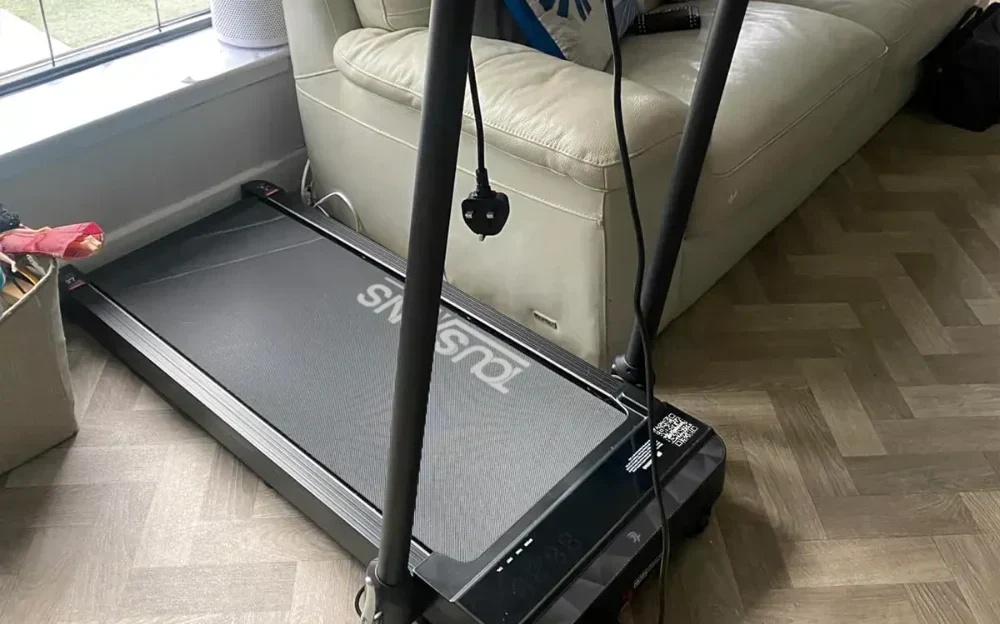Running is great cardio, but walking on a treadmill can offer many of the same benefits, according to experts at Texas Health Resources.
In this article, we will explain why incline walking works, what the science says, whether the treadmill 12-3-30 is suitable for you, and exactly what speeds/incline beginners should start with. Let’s take a closer look and explore the best incline treadmill for home: Tousains treadmill with incline FIT-7s.
What Are the Benefits of Walking on a Treadmill with Incline?
Better glute and quad activation
When you walk uphill, you extend your hip more on each step. At the same time, your quadriceps work harder to push you up the slope. In short, incline walking shifts work from mostly calves/quads on flat ground to more involvement of glutes and hamstrings.
More energy expenditure
A study from the National Library of Medicine found that energy demand rose about 52% at a 5% incline and roughly 113% at a 10% incline compared with level walking. Put simply, a modest hill doubles the work your body does at higher slopes, allowing you to burn far more calories in the same amount of time. [1]
Improved Knee Joint Health

Another study points out that incline walking reduces the internal knee-abduction moment, which may help slow cartilage wear, ease pain, and lower the risk of medial tibiofemoral osteoarthritis. [2] This makes it a joint-friendly option for older adults, people with obesity, or those recovering from knee surgery.
With an incline of up to 7 degrees, the Tousains treadmill with incline FIT-7s offers a compact, foldable option that fits small apartments, making it easier for users to support knee health through regular incline walking
Does the Treadmill 12-3-30 Help?
The treadmill 12-3-30 means that you should set the incline to 12% and walk for 30 minutes at the speed of 3 mph. It’s simple and brutally effective: the steep grade forces significant hip extension and raises metabolic cost, so you burn a lot of calories and heavily recruit your glutes without running.
A study comparing the 12-3-30 workout with self-paced treadmill running found that while it’s less time-efficient for total energy expenditure, it may promote greater fat utilization. [3]
However, it is intense. 12% for 30 minutes is challenging even for fit people and may be unsafe for beginners, those with balance issues, or people with certain knee/back conditions.
What Speed and Incline Should You Use to Burn Fat?
If you’re just getting started, the goal at the beginning is to build a sustainable habit, not to push your limits. A moderate incline of 5–7%, combined with a walking speed of 2.5–3.5 mph, works well for most beginners.
This range is challenging enough to elevate your heart rate and boost calorie burn, while still being comfortable to maintain for 30 minutes or more. As your endurance improves, you can gradually increase the intensity or try a shorter treadmill 12-3-30 workout occasionally.
Tips to Maximize Your Incline Walking Results
Don’t hold the handrails
Use them only for balance at the very start. Holding on reduces hip extension and cuts the effectiveness of the incline.
Brace your core and lean slightly forward from the ankles
A small forward lean (not hunched) helps you use the glutes. Think “tall, strong posture” while intentionally squeezing the glutes on each push.
Land heel first
Aim for heel-strike, then roll forward through the toe. This helps activate posterior chain muscles.

Take longer, deliberate strides uphill
Bigger steps increase hip extension and glute engagement.
Progress slowly
Increase incline or duration by no more than one level (or ~1% and 5–10 minutes) every 1–2 weeks.
Warm up and cool down
Start with 5–10 minutes of flat walking and finish with a cooldown and stretches for hamstrings and quads.
Final Thoughts
Incline walking, even at a small incline, not only better engages glutes and hamstrings, but it also significantly increases energy cost. The famous 12-3-30 protocol is very effective, but it’s not for everyone: start gentler (3–5% incline at 2.5 to 3.5 mph) and progress gradually.
For anyone who is looking for the best incline treadmill for home, the Tousains treadmill with incline FIT-7s is an ideal option to consider. With a 7° incline and a speed range of 0.6 to 7.5 mph, it helps you stay fit easily at home. And if you’re concerned about quality, Tousains offers a 2-year warranty on all home fitness products. If you’re ready to make walking a daily habit, the Tousains treadmill with incline FIT-7s could be the perfect place to start.
FAQ
How many calories do you burn on a treadmill?
The calories you burn depend on your weight, speed, incline, and effort. Incline walking increases metabolic cost substantially: research shows ~50% higher energy use at 5% vs flat, and roughly double at 10%. As a rule of thumb, expect a moderate incline walk to burn noticeably more than the same-speed flat walk.
Does incline walking build glutes?
Yes, incline walking increases hip extension on each step, which specifically targets the gluteus maximus. To maximize glute development, focus on longer strides, push through your heels, add higher-incline intervals, and combine walking with targeted strength moves (hip thrusts, deadlifts, lunges).
References:
[1] https://pmc.ncbi.nlm.nih.gov/articles/PMC4504736/
[2] https://www.sciencedirect.com/science/article/abs/pii/S0966636214000022
[3] https://pmc.ncbi.nlm.nih.gov/articles/PMC11798546/


